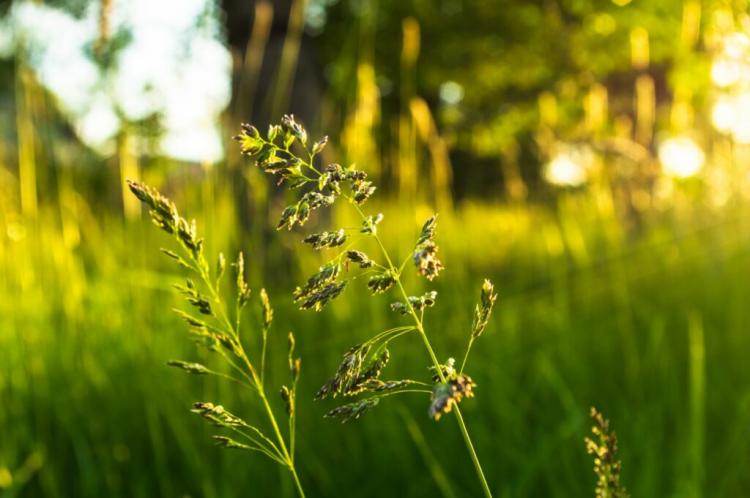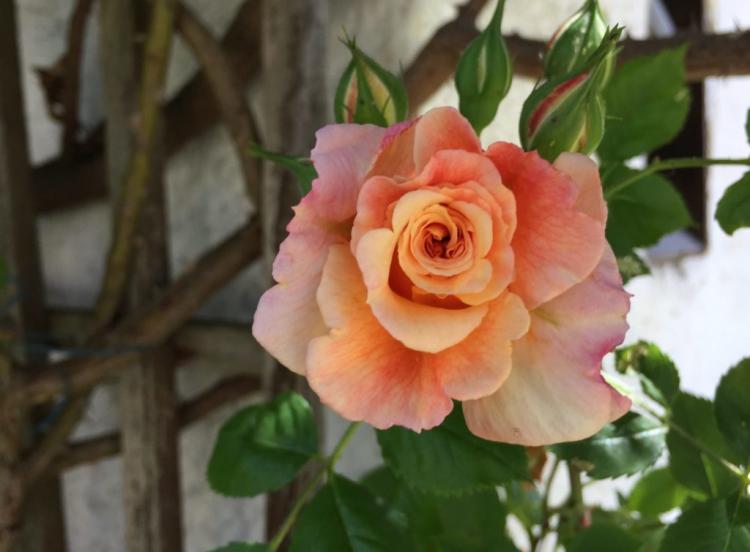Plate hydrangea: Everything for planting, caring for and cutting
The plate hydrangea (also called sawn hydrangea) catches the eye with its umbrella-like flowers. We reveal what you should consider when planting and caring for, and give precise instructions on how to cut the plate hydrangea.
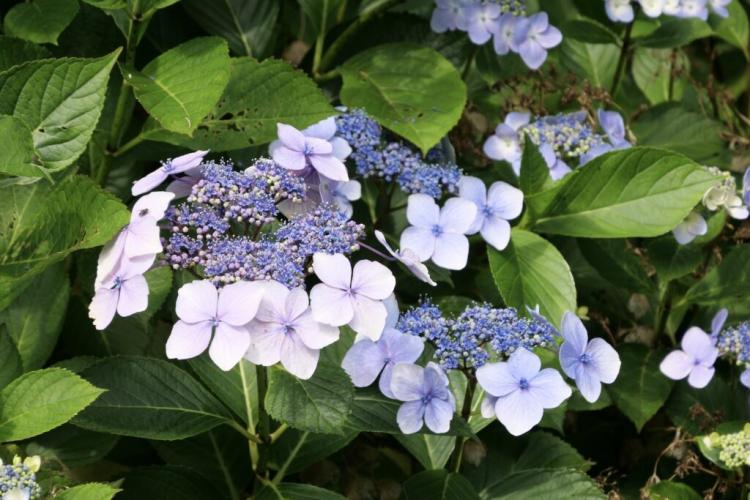
The plate hydrangea looks a little wilder than the closely related garden hydrangea [Photo: Wirestock Images / Shutterstock.com]
The plate hydrangea looks a little wilder and more original next to the lush garden hydrangea. Unlike some of their relatives, whose inflorescences are composed only of pseudo-flowers, plate hydrangeas also have numerous fertile flowers and are therefore a valuable source of food for insects in summer.
Plate hydrangea: flowering time, characteristics and origin
Table of Contents
The plate hydrangea (Hydrangea serrata ) is also known under the name Sawn hydrangea, Japanese mountain hydrangea or umbrella hydrangea and originally comes from the mountain forests of Japan. It grows as a spreading subshrub and reaches a height of up to 1.5 meters. During the flowering period from July to October, the umbrella-shaped flowers gradually open. In the middle are the rather inconspicuous fertile flowers, which are surrounded by a wreath of pseudo-flowers. These are composed of four to five oval petals. The approximately 10 cm large panicles shine in white, pink, purple, blue or in several colors, depending on the variety. In addition to the variety, the pH of the soil also has an influence on the color of the flowers. In alkaline or neutral soils, the flowers appear pink, but in acidic soils they are blue. The oppositely arranged leaves of the plate hydrangeas are bright green and tapered to a point.
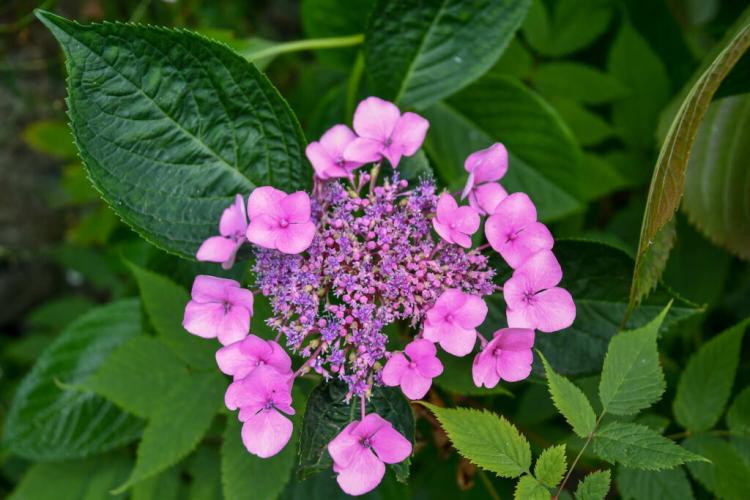
The flower umbrellas of the plate hydrangea are composed of fertile inner flowers and outer pseudo-flowers [Photo: Simona Sirio / Shutterstock.com]
Hydrangea varieties
The ‘Bluebird’ hydrangea variety is particularly well-known and popular. It is a short-stature variety. It has purple inner flowers with blue stamens. The outer pseudo-flowers are pale purple to blue in color. Since the color of the flowers depends on the pH of the soil, it can vary slightly depending on the location. To get the blue color, check out our dedicated article on how to dye hydrangeas blue.
In addition to the Hydrangea serrata varieties, there is also a large variety of hybrid breeds of Hydrangea serrata and Hydrangea macrophylla . Although these bear the species name Hydrangea macrophylla , they are very similar to Hydrangea serrata and are also known as plate hydrangeas. This group includes the plate hydrangeas ‘Lanarth White’ and Endless Summer ‘Twist-n-Shout’. The plate hydrangea ‘Lanarth White’ is very suitable as a container plant due to its small height and width of 90 to 120 cm. Their plate-shaped inflorescences are made up of white marginal flowers and, depending on the soil pH, pink or blue inner flowers. The variety Endless Summer ‘Twist-n-Shout’ in the color pink impresses with its dreamlike pink inflorescences, which contrast wonderfully with the dark green leaves.
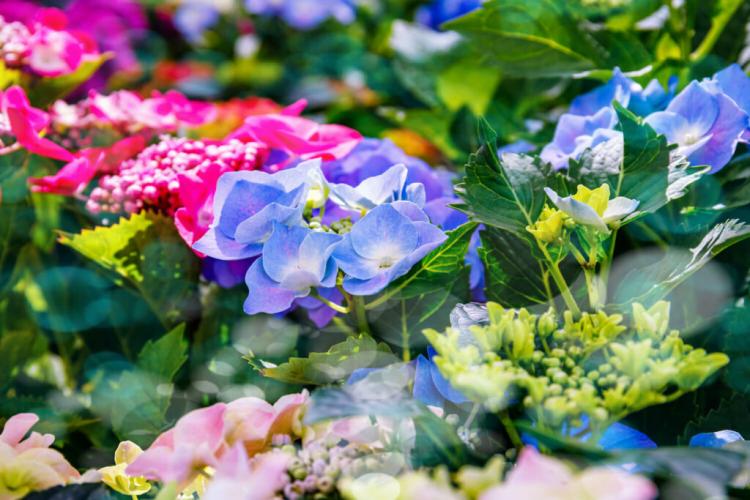
Plated hydrangea varieties with different flower colors are available in stores [Photo: nnattalli / Shutterstock.com]
Other hardy plate hydrangea varieties are Hydrangea macrophylla ‘Dragonfly’ and ‘Pheasant’. The flower panicles of the ‘Dragonfly’ variety look particularly elegant. Their pink inner flowers are surrounded by pure white marginal flowers. The flowers of the ‘Pheasant’ variety appear in strong purple. If you can’t decide on a color or are looking for something extraordinary, you might enjoy a multi-colored plate hydrangea such as Hydrangea serrata ‘Cotton Candy’, whose pseudo-flowers are pink and have small, creamy-white leaves in the middle. If the soil pH value is acidic, the pink can also turn into a delicate purple to blue shade.
Planting plate hydrangea: location and timing
Plate hydrangeas, like the closely related farmer’s hydrangeas, feel most comfortable in a partially shaded, sheltered location in the garden or on the balcony. In principle, hydrangeas can be planted all year round, but the ideal time is between March and June.
Umbrella hydrangeas prefer a humus and nutrient-rich, fresh to moist garden soil with an acidic or at least weakly acidic pH value between 4 and 6. An acidic soil makes it easier for them to take up nutrients, especially that of iron – planting in acidic soil increases the Hydrangeas prevent frequent iron chlorosis. Sandy, nutrient-poor and alkaline garden soils should be mixed with a suitable special soil such as our Plantura organic acid soil or replaced over a large area before planting. Very clayey soils should also be loosened generously deep in the ground at the bottom of the planting hole with drainage material such as sand, expanded clay or perlite.
Carefully loosen the plant ball of the plate hydrangea from the plant container and then loosen it up a little. This stimulates root growth. Then the plant bale is placed in a sufficiently large planting hole or in the prepared planter and this is filled with substrate. Press down firmly and pour generously. A regular and sufficient supply of water to newly planted hydrangeas is essential, especially when the high temperatures occur frequently in early summer. In addition, a mulch layer of leaves or bark mulch can be placed around the hydrangeas to keep the moisture in the soil longer. In order to use the water even more efficiently, a circular watering rim can be formed around the hydrangea plants from the remaining garden soil, which prevents the water from flowing off to the sides above ground.
Tip: Forest gardens and those on former bog areas are often already provided with acidic soil by the plants growing on them – it is therefore worth checking the soil pH value before buying a special acidic soil. However, the vast majority of garden soils in Germany do not offer optimal growing conditions for hydrangeas, which is why the humus-rich, acidic soil is often a good investment in beautiful hydrangea flowers.
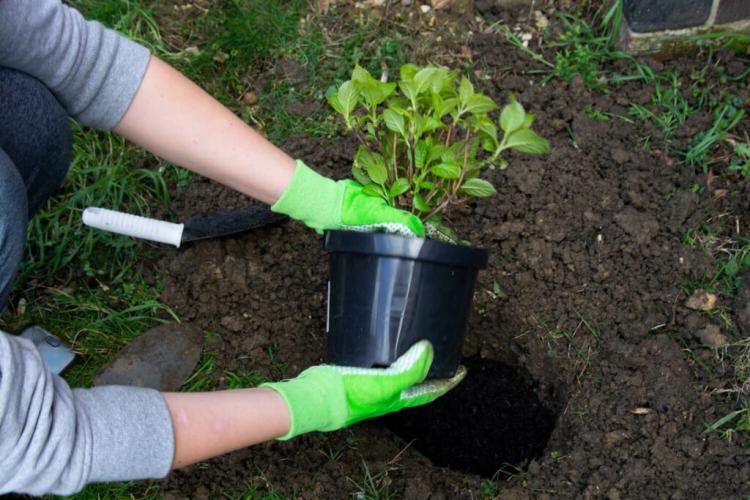
Hydrangeas should be planted between March and June [Photo: Erhan Inga / Shutterstock.com]
If you want to plant the plate hydrangea in a pot on the terrace or balcony, acidic soil such as our Plantura organic acidic soil is also ideal as a substrate. In addition to the right soil, choosing a suitable bucket is also important. It should be big enough and the bottom of the vessel should definitely have a drainage hole so that excess irrigation water can run off without problems and no waterlogging can occur. Glazed pots or plastic containers are better suited than open-pored clay pots, as they do not lose water as quickly.
Maintain plate hydrangea
Like all hydrangea species, plate hydrangeas have an extremely high water requirement and have to be watered regularly in summer, possibly even twice a day on hot days. Particularly with potted hydrangeas, due to the smaller volume of soil, it is important to ensure that the substrate does not dry out. Umbrella hydrangeas are sometimes sensitive to lime. Hence, it is best to use rainwater for watering. Not only do you do something good for your hydrangea, you also save valuable drinking water. If you don’t have a rain barrel, tap water with little lime or water that has been acidified with a small amount of peat is also suitable. In order to make the best possible use of the water, in addition to the water-saving measures mentioned above (mulch layer and watering edge), it is best to water in the morning or in the evening, when the solar radiation and thus the evaporation are low.
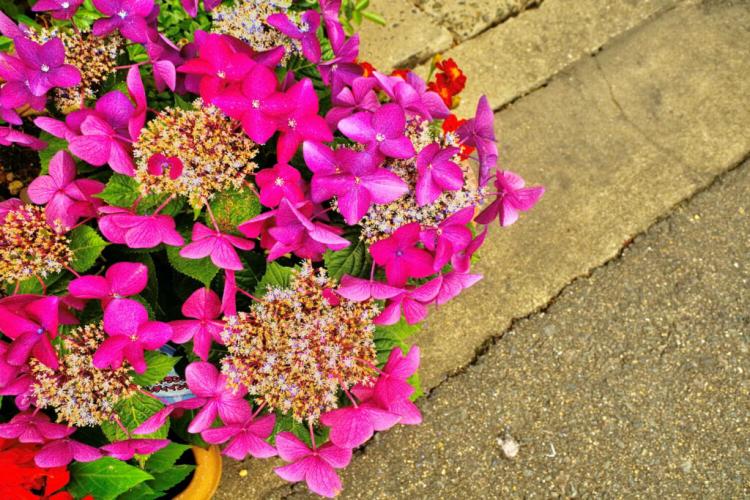
Pot hydrangeas in particular should be watered at least once a day during the summer months [Photo: ajisai13 / Shutterstock.com]
Cutting hydrangeas: this is how you go about cutting back
Plate hydrangeas are rarely cut. In spring, the dead inflorescences are removed just above the new buds and frozen or dried-up parts of the plant are removed from the bush by hand or with scissors. If the plate hydrangea becomes too spreading and bushy, it can be thinned out a bit by completely removing a few shoots at the base.
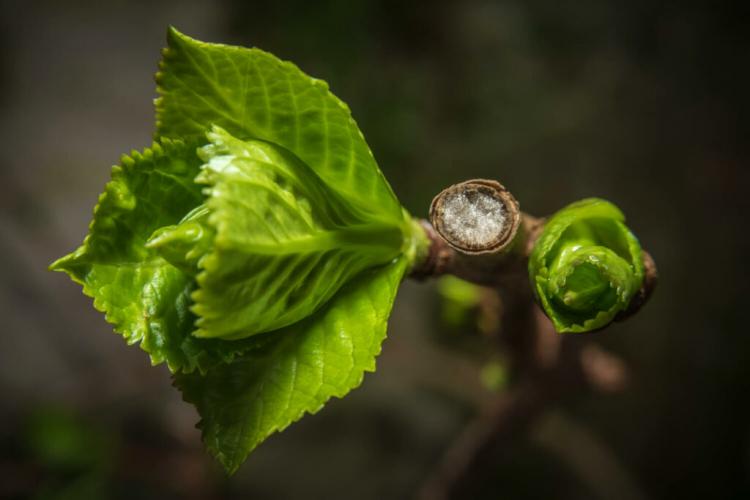
In spring, dead plant parts are cut off just above the new buds from which the annual flowering shoots sprout [Photo: Jay-Dee / Shutterstock.com]
Fertilize plate hydrangeas
Separate fertilization is not absolutely necessary for plate hydrangeas in the flowerbed if the garden soil is good and is occasionally supplied with compost. In the case of potted hydrangeas, however, it is advisable to apply fertilizer annually to replenish the nutrient supply in the limited pot volume. Our Plantura organic hydrangea fertilizer with a three-month long-term fertilization is ideal for this. It supplies the soil with extra iron and can thus prevent typical deficiency symptoms and diseases. Spring is the right time to fertilize plate hydrangeas. Spring fertilization gives the plate hydrangeas a good start to the growing season. If necessary, you can add another fertilizer in summer, as you can read in our article on fertilizing hydrangeas. The hydrangea should not be fertilized in late summer and autumn or even winter, as this may result in increased frost damage.
Tip : A layer of mulch, which keeps the moisture in the soil longer, improves the effectiveness of the hydrangea fertilizer. But be careful: hydrangeas have very shallow roots. Therefore, you should not work the fertilizer under the hydrangeas, as this could damage the roots.
Hibernate plate hydrangeas
Plate hydrangeas are hardy in our latitudes. Well-hardened plants from specialist shops are robust and generally do not require winter protection in the flowerbed. However, it is not uncommon for individual shoots to die off and have to be removed every year. In rough locations, the shallow roots can be protected from the effects of frost with a layer of leaves or fir branches to be on the safe side. Plate hydrangeas growing in the bucket should be overwintered in a sheltered place, for example a corner of the house, and possibly under a roof. In the event of prolonged low temperatures, a garden fleece or jute sack can be placed around the plants as protection against frost damage.
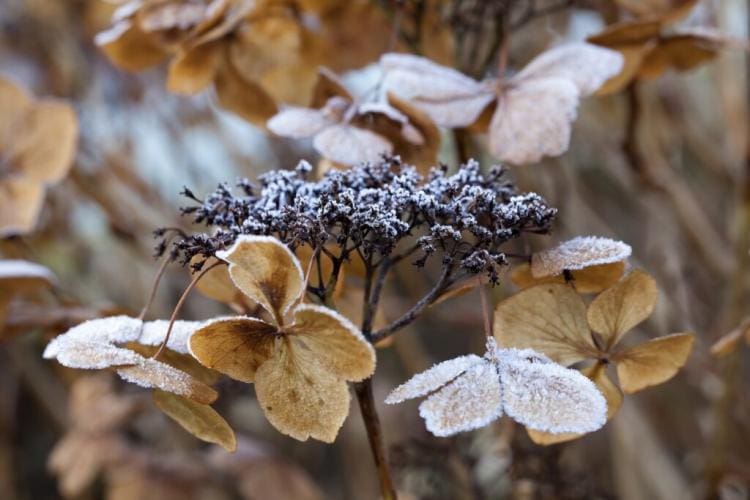
Plate hydrangeas are hardy in our latitudes [Photo: Sue Robinson / Shutterstock.com]
Propagate plate hydrangeas
Plate hydrangeas, like the related garden hydrangeas and other hydrangea species, can be propagated using cuttings. These are cut between June and July. From the rods 10 to 15 cm long, weakly woody and vital shoot tips without flower buds are cut off. Then, except for the upper pair of leaves, all leaves are carefully removed and the cuttings are then placed 2 to 3 cm deep in cultivation containers filled with substrate. A peat-free seed soil such as our Plantura organic herb & seed soil is suitable as a substrate. With a little sand or perlite, the substrate permeability is increased and improved rooting is achieved. The substrate in the growing containers must be kept moist at all times. The best way to moisten it is with a spray bottle. In a bright place without direct sunlight and at a temperature of around 15 ° C that is as constant as possible, the cuttings take root and grow into new young hydrangea plants.
If you are also interested in other hydrangea species, you can read on in our special article about panicle hydrangeas and get to know interesting varieties of this species.



